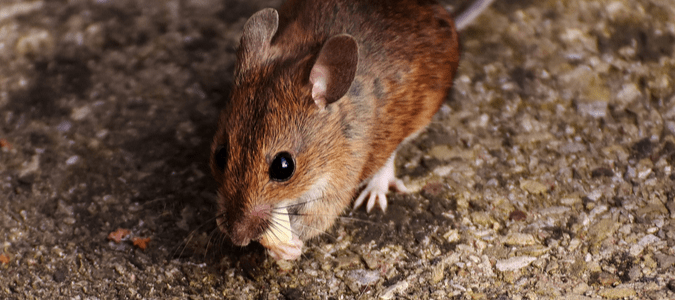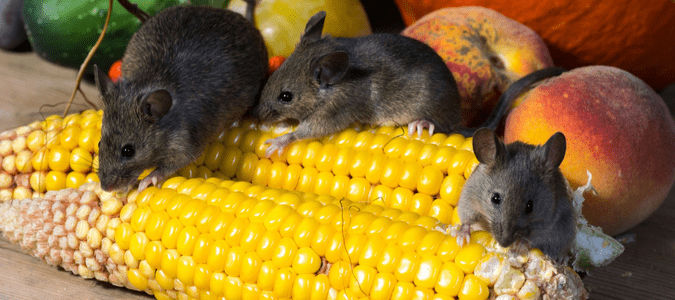
Finding a mouse in the home—or, even worse, more than one—sends most people into a frenzy of worrying about whether or not there’s an actual infestation. You may be pacing around your home wondering what to put in a mouse trap and where to place these devices, because no matter how small and cute they may seem on TV and in pictures, mice definitely are pests.
When thinking of what to put in your mouse trap, your mind might instantly go to cheese. In reality, a mouse’s favorite things to snack on are fruits, nuts, seeds and other sweet foods, so these will be your best bet when baiting a trap. However, mice also eat anywhere from 15 to 20 times a day, so if they are hungry, they will eat whatever they can get their paws on. In desperate times, they will even eat each other!
If you have reached your wit’s end and you’re ready to set some traps, try the following baits that have been proven to be irresistible to these furry rodents:
- Smooth or chunky peanut butter
- Hazelnut spread
- Chocolate
- Birdseed or nuts
- Maple syrup
- Bacon bits or grease
- A sliced up hot dog
- Salami
- Soft cheese
- Pet food
Some homeowners have also been known to trap mice by luring them with nest building materials such as yarn, floss and cotton balls. When setting these traps, it’s important to use bait that mice can’t easily find in your home. For example, hazelnut spread may be worth the extra couple bucks next time you stop by the grocery store, as the mice will be excited about this new, sugary food source that they can’t find anywhere else.
Keep in mind that it’s not just about the type of bait you use—you should consider the amount of bait and the placement of your traps as well. And, if mice are infesting your home, a few snap traps won’t be nearly enough to control the problem. How many mice is considered an infestation? Since one female mouse can have up to sixty offspring in one year, you don’t need to have many living in your home to develop a larger problem.
These creatures carry bacteria and diseases that can be harmful to people and their pets. To shave down their constantly growing teeth, mice have been known to gnaw through wood, drywall and even electrical wiring. When they build a nest, their urine and feces can seep through ceilings and walls and cause further damage. When mice get into your pantry, these rodents can chew through cereal boxes, packages of pasta and other items in search of food, and anything they get into is tainted and no longer fit for human consumption. These are just a few of the reasons why it’s so important to act quickly if you find a mouse in your home.
Now that you have some recommendations on what to put in your mouse traps, the next question you probably have is where to put them to make sure your mouse population doesn’t quickly get out of hand.

Where To Place Mouse Traps
The first step in determining the best place for mouse traps is to find areas with evidence of mouse activity. For example, if you are seeing gnawed cereal boxes in your kitchen, that would probably be a good place to start for laying traps. Be sure to use multiple traps and to set these in out of the way spots like inside the pantry, on top of or inside cabinets, behind kitchen appliances or next to any places where you suspect these furry animals might be entering the home. You can also set out traps inside your attic or garage if you see evidence of rodent activity in these parts of your home. Place traps next to the wall to be more effective and not out in the open. Setting traps along these more protected possible mice passageways will also minimize the risk of a family member or pet being injured by a trap.
Knowing where mice are most likely to go depends on knowing these animals’ habits and needs—essentially, why a mouse might enter your home in the first place. Mice are attracted to people’s homes for the same reason as any other pest: They are seeking to fulfill their three basic needs, which are food, water and shelter. Unfortunately for a homeowner, our living structures are great sources of all three.
Mice can get into the home through even very tiny openings. These creatures have been known to access people’s homes through small gaps around doors, windows and eaves. Mice and rats can also gain entry through small holes in the exterior walls of a house where water pipes or gas lines feed into the home. Any crack or hole that is wider than the diameter of a pencil is large enough for a mouse to squeeze through. If you want to prevent mice from entering your home, it’s a smart idea to close off all openings with wire mesh, steel wool, caulk or other materials.
Unfortunately, even with the perfect bait and trap placement, homeowners can still encounter problems with their traps.

Common Problem: Mouse Keeps Eating Bait Off Trap
It can be frustrating to discover when you check your traps that a mouse has maneuvered the bait out of the trap without getting caught. The silver lining to this annoyance is that you know the bait you’re using is appealing to the mouse.
If a mouse keeps eating the bait off your trap, you are probably putting too much of the bait on your trap. A pea-sized amount is about right; using much more than that makes it easier for the mouse to grab some of the bait from a distance without engaging the spring mechanism. Using a smaller amount of bait forces the mouse to come closer to the trap in order to get at the bait, making it more likely that you’ll catch this unwelcome intruder.
Keep in mind that bait should be replaced every few days, or at least once a week, in order to keep it fresh and appealing to a mouse. Also, you’ll want to wear plastic gloves when handling the bait instead of touching these foods with your bare hands, since mice tend to avoid bait foods that carry human scents. It’s also a good idea to make sure all human and pet foods are stored in airtight containers that mice can’t access, in order to limit the rodents’ access to other foods. Doing this before you set out your traps will make the mice hungrier and therefore more likely to go after the bait food in your traps.

Another Issue: Mouse Trap Disappeared
Another common scenario is when you set out a mouse trap and wait for the mouse to test it out and somehow the mouse trap disappears. Where could it have gone? Did a mouse or some other animal drag it off?
If you’ve set out a mouse trap that seemed to have vanished into thin air, what probably happened is that the mouse, or some other rodent or animal, got its whiskers, tail or some other body part caught in the device, and was then able to run off with the trap still attached. For a standard snap trap to work, the metal bar should ideally kill the mouse by snapping down onto its neck. If the bar snaps down onto a non-essential body part, such as a whisker or tail, the mouse can get away with the trap attached to its body. This will be painful and cumbersome for the mouse, but not lethal.
To avoid disappearing mouse traps, set your trap perpendicular to the wall, with the trigger closest to the wall. This will help to ensure that mice encounter the bait directly and don’t run over the trap in the wrong direction, prematurely setting it off.

What If Your Mouse Trap Is Not Working?
Perhaps the most frustrating situation is to have a mouse in your home and set out traps, only to find the mouse trap is not working as you had expected. This is a common issue with mouse traps, and often it has more to do with user error than with any problem inherent to the trap itself.
If you’ve tried using mouse traps but found that they didn’t work, revisit these tips and see if you get better results:
- Use multiple traps, and plenty of them, even if you think you have only one or two mice. Setting out six to twelve snap traps in order to catch one or two mice is not unreasonable. You may be wondering: If I see one mouse, how many do I have? The answer might surprise you, so err on the side of putting out more traps rather than fewer.
- Use gooey, high-interest bait, such as peanut butter, but only a small amount, and don’t touch it with your bare hands. A pea-sized amount is usually enough to attract the mouse and force it to spend plenty of time at the trap, trying to access the food.
- Set traps along the wall, perpendicular to it, with the non-trigger side facing out to the room. Alternatively, set two traps together, end-to-end, perpendicular to the wall.
- Replace the bait on your traps every two to three days to keep it fresh and enticing for the mice.
Remember, if you’re having trouble dealing with a mouse problem on your own, contacting a professional exterminator is generally the best course of action. Pest control specialists know the best types of mouse traps and bait to use as well as the best spots to set them out in order to maximize the chances of catching mice. Outsourcing this task will also help you avoid having to deal with the unpleasant experience that is finding that your traps have worked and needing to dispose of these rodents’ bodies, especially since they quickly begin smelling, making your problem seem even worse.
ABC Can Address Your Mouse Problem
Even with properly set traps, mice populations are extremely difficult to control because these animals are prolific breeders. These sneaky rodents can fit through holes the size of a quarter to enter your home. If you are successful in trapping the mice which have taken up residence on your property, you still have to worry about disposing of these pests and the safety risks these animals pose. Instead of taking all of this on yourself, let the professionals at ABC Home & Commercial Services take care of your mouse infestation. We can trap these creatures, remove them from your property and seal up all holes and cracks that future rodents could use to gain entry to your home.
